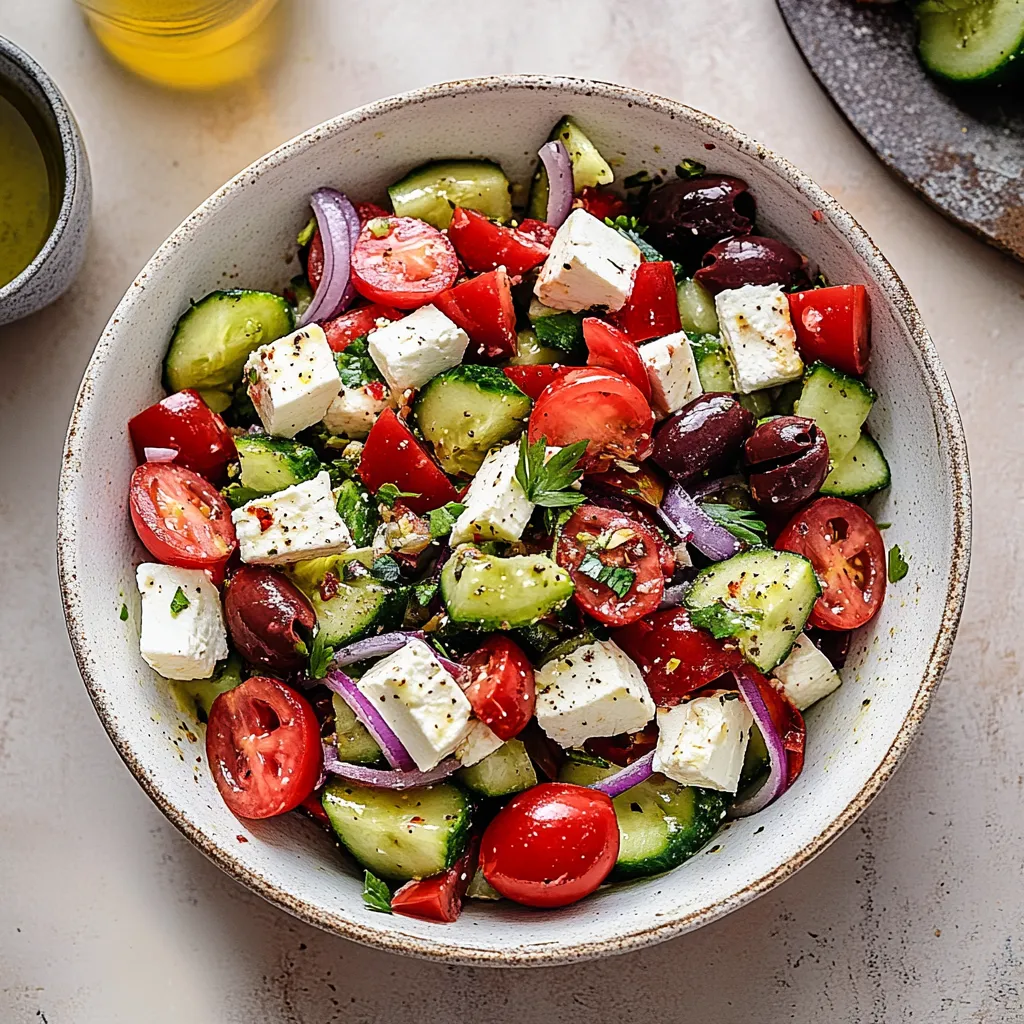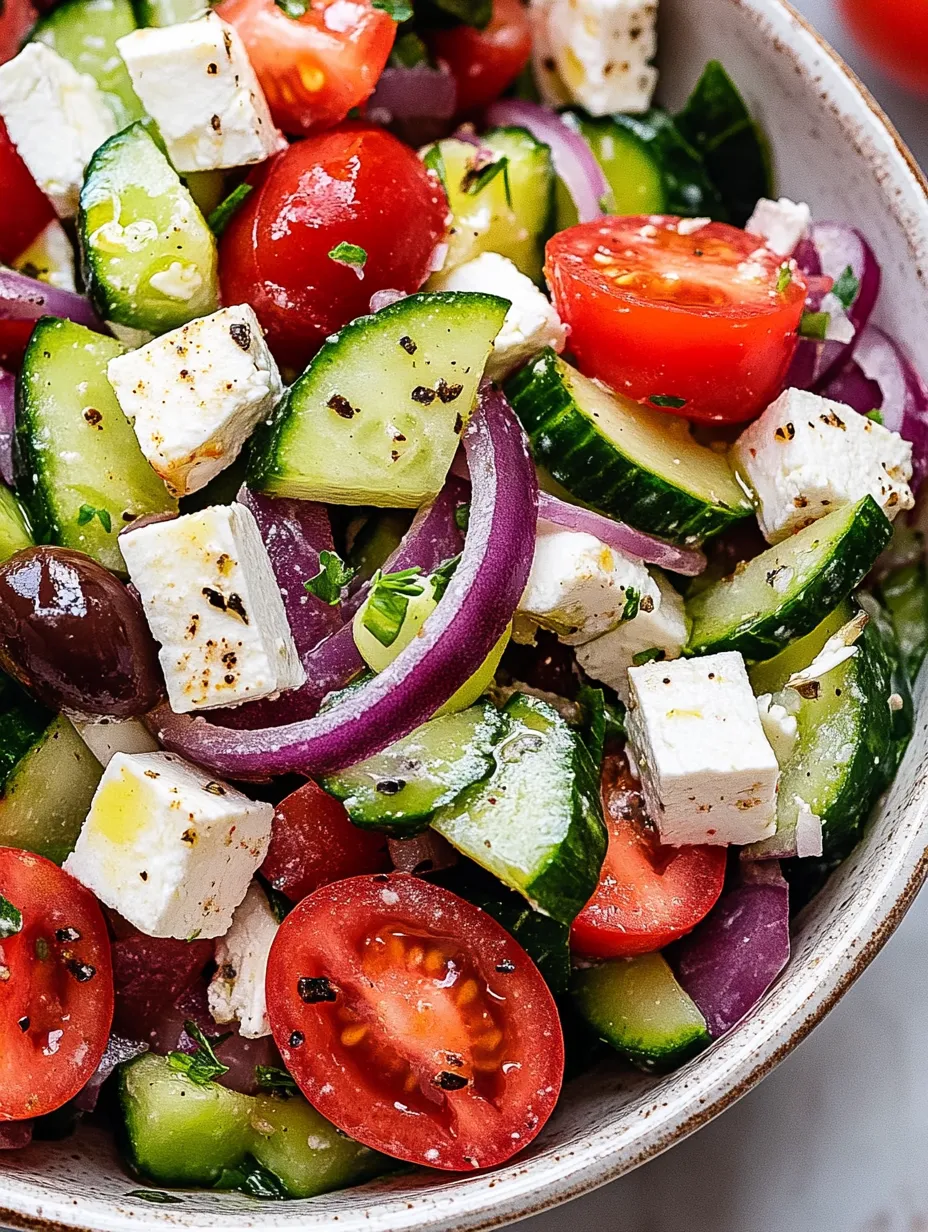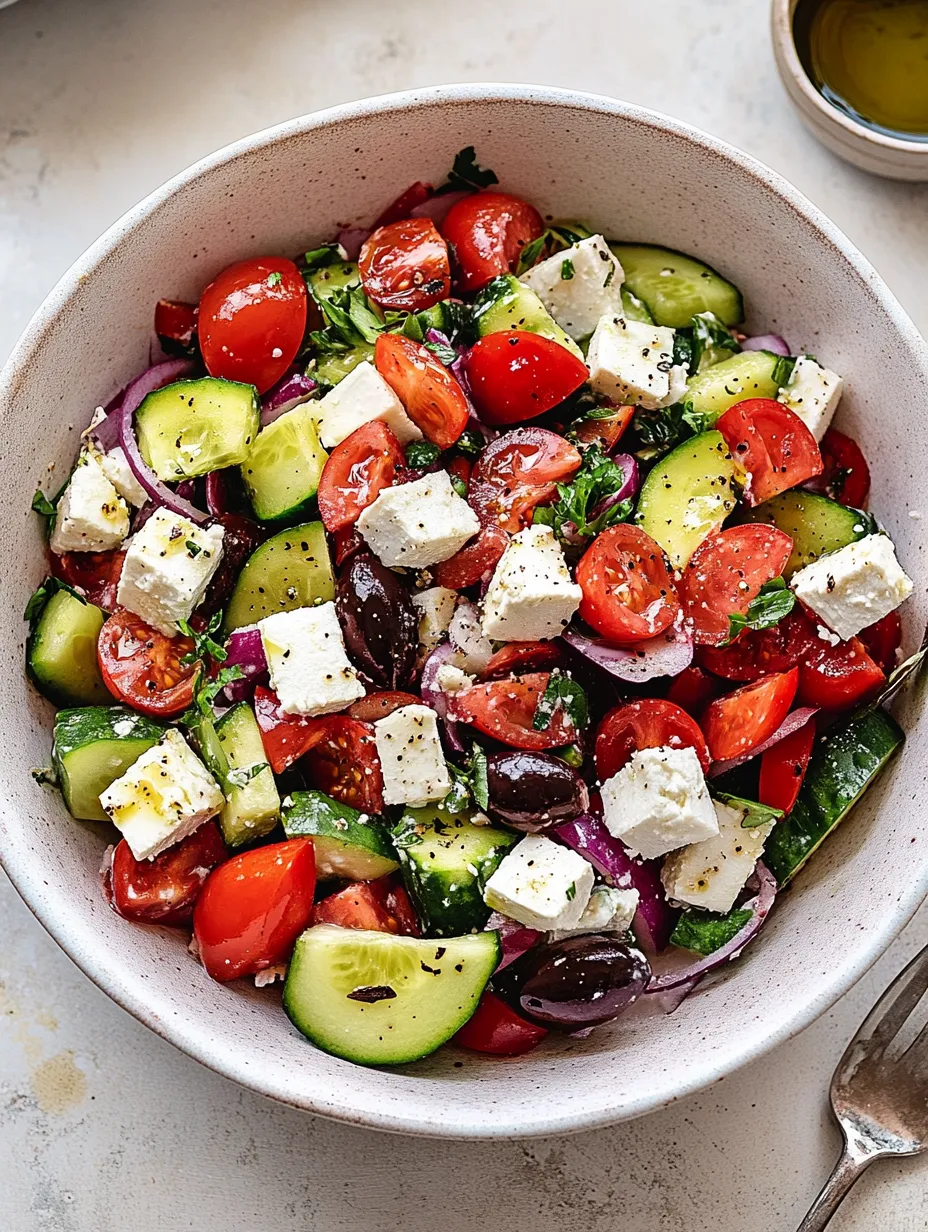 Save
Save
This vegan Greek salad has become my summer staple, offering all the Mediterranean flavors without any animal products. The combination of crisp vegetables, briny olives, and creamy vegan feta creates a refreshing dish perfect for hot days.
I first made this salad for a neighborhood potluck, skeptical that vegan feta could stand in for the real thing. To my surprise, even the dedicated cheese lovers couldn't stop raving about it, and now it's requested at every summer gathering.
Ingredients
- English cucumber provides the perfect crunch and has fewer seeds than regular cucumbers
- Ripe tomatoes bring sweetness and juicy texture look for bright red ones with a slight give when pressed
- Bell pepper adds color and crispness green or red both work wonderfully
- Red onion delivers sharp flavor and beautiful purple color soak in cold water briefly to mellow if desired
- Kalamata olives contribute essential briny flavor and authentic Greek character
- Vegan feta cheese the Violife Greek White brand mimics traditional feta's crumbly texture and saltiness
- Extra virgin olive oil forms the base of the dressing use the best quality you can afford
- Red wine vinegar and lemon juice provide perfect acidity balance
- Dried oregano is the quintessential Greek herb that ties everything together
- Dijon mustard acts as an emulsifier for the dressing while adding subtle depth
- Maple syrup just a touch balances the acidity without making it sweet
- Fresh garlic brings aromatic complexity to the dressing
Step-by-Step Instructions
- Prepare the cucumber
- Start by peeling alternating strips of skin from your cucumber for visual appeal and textural contrast. Cut it lengthwise then slice into half-moons about 1/4 inch thick. The striped peeling not only looks beautiful but provides a perfect balance of tender flesh and slight crunch from remaining skin.
- Prepare the tomatoes
- For large tomatoes, cut into wedges about 1-inch thick. For cherry tomatoes, simply halve them. Ensure your cutting board has a groove to catch the flavorful tomato juices you want those in your salad.
- Prepare remaining vegetables
- Dice the bell pepper into 1/2-inch pieces and slice the red onion very thinly. Keeping the onion slices thin prevents them from overpowering the other ingredients. The olives can remain whole for dramatic presentation or be halved for easier eating.
- Cube the vegan feta
- The key to authentic presentation is cutting the feta into uniform cubes. First slice into 5 long strips, then cut each strip into 5 pieces, creating perfect little cubes that distribute evenly throughout the salad.
- Combine vegetables
- Place all prepared vegetables and vegan feta in a large bowl, ensuring you have enough space to toss everything without spilling.
- Make the dressing
- In a separate small bowl, combine all dressing ingredients and whisk vigorously until emulsified. The mustard helps bind the oil and acidic ingredients together, creating a cohesive dressing that coats each ingredient beautifully.
- Assemble the salad
- Pour the dressing over the vegetables and toss gently but thoroughly with salad tongs. Finish with a sprinkle of additional dried oregano on top for visual appeal and fresh aroma.

The kalamata olives are my secret favorite ingredient in this recipe. Their deep purple color and rich, wine-like flavor remind me of summers spent on Greek islands, where similar salads were served alongside freshly baked bread and the Mediterranean breeze.
Make-Ahead Tips
This vegan Greek salad can be partially prepared in advance to save time. Cut all vegetables except tomatoes and store them separately in the refrigerator. Mix the dressing and store in a jar. When ready to serve, add tomatoes and vegan feta, then toss with the dressing. This approach keeps everything fresh while allowing the flavors to develop.
Customization Options
While this recipe captures authentic Greek flavors, feel free to make it your own. Add chickpeas for protein, toss in some arugula for peppery notes, or include avocado for creaminess. For a grain version, mix in cooked and cooled quinoa or orzo pasta. The dressing works beautifully with any of these additions, making this salad adaptable to what you have on hand.
Serving Suggestions
Serve this vibrant salad alongside grilled vegetable skewers, vegan moussaka, or stuffed grape leaves for a complete Mediterranean feast. For a simpler meal, pair with warm pita bread and hummus. This salad also makes an excellent topping for a grain bowl with farro or bulgur wheat as the base.
Cultural Context
Traditional Greek salad, known as "horiatiki" or village salad, never contained lettuce but focused on showcasing the quality of fresh vegetables. This vegan adaptation honors that tradition while making it accessible to plant-based eaters. The key to authenticity lies in simplicity allowing each ingredient to shine without unnecessary additions.

Recipe FAQs
- → What can I substitute for vegan feta?
If you can't find Violife Greek White or another vegan feta, you can use tofu marinated in lemon juice, olive oil and salt for a similar texture. Alternatively, try other plant-based cheese with a tangy flavor, or simply omit it for a lighter salad.
- → How far in advance can I prepare this salad?
You can prepare the components up to 24 hours ahead, but for best results, keep the dressing separate and combine everything just before serving. This prevents the vegetables from becoming soggy and maintains their crisp texture.
- → Can I add other vegetables to this salad?
Absolutely! While the classic combination uses cucumber, tomatoes, peppers and onions, you can add artichoke hearts, roasted red peppers, or even lettuce. Just maintain the Mediterranean flavor profile for authenticity.
- → Is this salad suitable for meal prep?
Yes, but with some adjustments. Prepare all components separately and store in airtight containers. Keep the dressing in a separate container and combine everything when ready to eat to maintain freshness and prevent sogginess.
- → What can I serve with this Greek salad?
This versatile salad pairs beautifully with pita bread, hummus, falafel, or grilled vegetables for a complete meal. It also makes an excellent side dish for Mediterranean-inspired mains like stuffed peppers or pasta dishes.
- → Why peel only half the cucumber?
Peeling alternating strips of cucumber skin creates an attractive appearance while maintaining some of the nutritional benefits and color from the skin. It also provides a pleasant textural contrast between the tender peeled sections and slight crunch of the skin.
